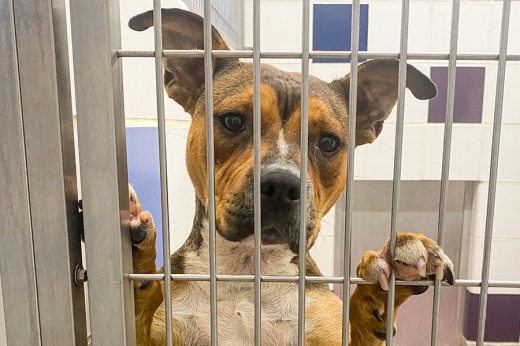Misty Valenta, Williamson County Regional Animal Shelter animal services director, said due to several reasons, including more families in crisis needing to offload pets, her shelter has been at critical capacity since at least last year, and it is often a day-to-day struggle just to manage the population.
As of late-April, the WCRAS dog population was at 169% capacity.
Meanwhile, Rhonda McLendon, director of animal welfare services for the Pflugerville Animal Shelter, said the city facility is maintaining a manageable population but continues to increase additional adoption efforts to keep the population under control.
However, both shelter leaders said they expect their animal populations to grow in the coming months as kitten populations tend to rise substantially in late spring.
Amid the ongoing capacity struggles, shelter staff, nonprofits, volunteers and area officials continue to search for solutions to a problem they said is likely not going away anytime soon.
“We’ve been putting out a lot of asks to our community, to our volunteers, to our fosters just to make it through, literally sometimes day by day,” Valenta said.
Defining the problem
Round Rock resident Summer Pavliska has fostered more than 30 dogs over the last 15 years.
Pavliska said shelter capacity issues grew soon after COVID-19 pandemic restrictions started lifting.
“Everyone was getting a dog because everyone was sheltering in place. The dogs would keep them company,” she said. “Then the world starts opening up, and they no longer want the dog, and they take them back to the shelter.”
Other local experts cite additional reasons for the population spikes at animal shelters.
Sheila Smith is the founder of Round Rock-based nonprofit Shadow Cats, which maintains a sanctuary for special needs cats and helps control stray populations through trap-neuter-return programs.
Smith said other reasons for shelter population spikes could include a reduction in affordable spay and neuter services.
Valenta disagreed that COVID-19 is a major reason for the capacity issues, at least at the WCRAS, and said she believes the biggest reason has to do with families in crisis needing to get rid of their pets.
Regardless of what's causing the population jumps, local shelter officials say more needs to be done.
April Peiffer, Williamson County Regional Animal Shelter program coordinator, said despite a recent expansion of the facility, shelter spikes are keeping pace with and surpassing available capacity even though the WCRAS budget continues to increase. The budget rose to $2.8 million in fiscal year 2022-23 from $2.6 million in FY 2021-22.
In 2019, the county shelter completed a $10.5 million renovation and expansion, adding a new adoption center in a separate two-story building with 64 additional canine kennels and 93 feline kennels.
After the expansion, critical capacity for dogs at the WCRAS rose to 170 or higher, and a comfortable capacity became 110 or lower, she said. As of late April, the dog population at the shelter rose to 186.
“I don’t know that we’ve ever gotten into trouble with cats in the same way we are with dogs right now,” Peiffer said.Finding solutions
Peiffer said one reason it has been so difficult for the WCRAS to get below capacity, at least for dogs, has to do with the service area.
Like Pflugerville’s shelter, the WCRAS enforces geographical limitations on the animals it intakes, meaning staff works to ensure the animals taken in come from within Williamson County.
However, the WCRAS service area is much larger than Pflugerville’s and includes all of Williamson County minus Georgetown and Taylor, Peiffer said.
The Pflugerville shelter only takes in animals within the city limits. The Austin Animal Center services the city's extraterritorial jurisdiction and all other unincorporated areas within Travis County. The WCRAS services a small portion of the Pflugerville ETJ in Williamson County.
To help keep the WCRAS from going too far overcapacity, Peiffer said WCRAS staff and volunteers have ramped up efforts in recent months, spearheading more adoption events and boosting community outreach efforts, among other initiatives.
Similarly, McLendon said the Pflugerville shelter is constantly seeking new fosters, holding adoption events and running social media promotions.
“So we’re managing our intake right now, but man, we can be in good shape, and then the next day we’ve got to do something because there are so many animals coming in,” she said.
On a larger level, in late March, Williamson County officials approved an agreement with the city of Georgetown to conduct a $50,000 feasibility study on the viability of discontinuing the Georgetown Animal Shelter and expanding the WCRAS.
If the study, which officials said should be complete by summer, shows it would be practical for all of the participating entities, the city would call a bond election in November to acquire the funding. If the bond passes, a new agreement would be drawn up to allow Georgetown to formally join the regional animal shelter.
“If [the study] finds that we can work together to build a building that would accommodate for everyone and accommodate for growth, then that would really help so many situations,” Valenta said.





